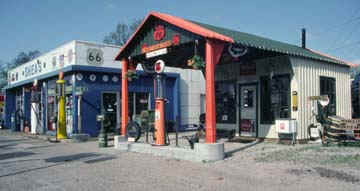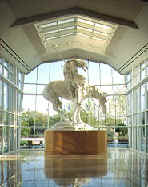In
downtown Chicago, Jackson, now a one-way street east, is the original Route 66.
Lou Mitchell's Restaurant (565 W. Jackson) at Jackson and Jefferson near
Union Station, has been on Route 66 since 1923, three years before the road was
first commissioned and only 800 miles were paved. So begin your adventure with a robust breakfast or lunch at
this diner shadowed by the Sears Tower.
For
explicit directions on following the old road from one end of the state to the
other, use Traveling the New, Historic Route
66 of Illinois (ISBN: 0-960-4576-3-1) by John Weiss.
Those
who are not Route 66 purists make the journey to hit the highlights between Chicago
and Springfield, then tour the Lincoln-related sites in Springfield. When detours off I-55 are made to seek out a few reminders of the old route,
travelers are well rewarded.
Take
I-55 (Stevenson Expressway) south out of Chicago past Joliet, getting off at Wilmington
to stop for a photo with the Gemini Giant at the Launching Pad Drive In, 810 E.
Baltimore/Route 53. The Giant's been
welcoming patrons since the '50s.
A
few miles further south, plan a snack break at the Polka Dot Diner (222 N. Front
St., Braidwood) opened in 1956 and popular with the 50s-60s crowd. Chili cheese fries are a specialty here.
At
all of these stops proprietors talk of many motorcar tour groups coming from Europe
to make the trek through to California in 30 days, some in vintage vehicles, others
on motorcycles.
Continue
south on I-55, exiting at McLean for the Dixie Truck Stop (Route 136 & I-55)
with its Route 66 Hall of Fame, a grassroots collection of stories and photos
honoring some of the people along the Illinois Road. You'll also find a good selection of Route 66 kitsch souvenirs here.
Return
to I-55 south to Springfield with more enticing Route 66 sites to visit. Enjoy a diner experience at Jungle Jim's Cafe (1923 Peoria Road) where
the decor reflects the owner's background in car racing.
 |
Shea's Gas Station Museum, Springfield
Photo by Ann Hattes |
At
coffee break time, drop in to see Buz Waldmire at his Cozy Drive In (2935 S. Sixth St.). Edwin Waldmire was the inventor of the popular American fare - the Cozy Dog, a
deep-fried, batter-wrapped, wiener-on-a-stick - more widely known as the corn
dog. A cozy dog sells for $1.50;
the early ones sold by his father were 15 cents. The flour covering the cozy dog
is a secret formula that only Buz and the flour mill know, although it is available
retail in one and five pound packages for fans to take home.
Route
66 historians and aficionados consider the Cozy Dog the road's original fast food.
Buz's father first sold them as "Crusty Curs" on weekends along Route
66 in Texas and Oklahoma when he was stationed in Amarillo in the mid-1940s.
Buz's
brother, Robert Waldmire, is an itinerant artist who has traveled the entire Route
66 several times, illustrating a series of postcards of things to see along the
way.
No
drive along "66" is complete without a stop at Ted Drewes, a landmark
custard stand and a St. Louis institution. Try the "concrete," a milkshake so thick you can turn it upside
down without spilling a delicious drop.
Small
family-style amusement parks were a staple along old Route 66. Modern I-44 West leads to the state-of-the-art in family fun, Six Flags
St. Louis, with shows, games and amusement rides for every age group. Thrill seekers try the latest roller coaster, The Boss, a 5000-foot wooden roller coaster that stands 120-feet tall
and travels at 65 miles per hour.
In
years past, a glimpse out the car window along Route 66 offered views of rolling
farmland dotted with cows and horses. Purina
Farms provides city slickers with a chance to interact with farm animals in a
charming barnyard setting.
The
famous five-story high Meramec Caverns and the billboards luring travelers to
"Visit Jesse James's Hideout" are still around. Lester Dill, who opened the massive cave as a tourist attraction, says:
"I've put more people underground and brought them out alive than anyone
else.
 |
National
Cowboy & Western Heritage Museum, OKC |
In
Oklahoma, see the Will Rogers Memorial in Claremore and the National Cowboy &
Western Heritage Museum in Oklahoma City.
In
neighboring Texas, visit the Panhandle-Plains Historical Museum, the largest history
museum in Texas, and the American Quarter Horse Heritage Center and Museum in
Amarillo. And at the Big Texan Steak
Ranch, take the challenge. Devour
a 72-ounce steak in one hour, and it's free!
"Oklahoma
is the longest part that feels like an old road," says Jamie Jensen, author
of Road Trip USA.
Route
66 is an important piece of New Mexico history, the backbone to economic development
and tourism from 1926 to 1984. New Mexico has the largest remaining inventory
of roadside architecture including both buildings and signs related to Route 66,
and Albuquerque claims the longest intact stretch (18 miles) of Route 66. In Albuquerque, the original Route 66 followed old roads like "The
Royal Road of the Interior Lands" connecting Spanish colonial capitals, and
an 1880 main rail line.
"Many
of our great buildings which represent the hay-day of Historic Route 66 remain,"
writes Albuquerque Mayor Jim Baca to Route 66 fans. "Modern streamline and pueblo deco architecture highlighted by classic
neon, motels, cafes and curio shops are still a vital part of our neighborhoods'
economies." At 2455 Isleta SW,
for example, see a "mushroom" gas pump canopy circa 1930s.
Today,
New Mexico's Route 66, part of a national scenic and historic byway, awaits in
six long, paved segments that are easily accessible from Interstates 40 and 25.
Dotted
with mom-and-pop restaurants, neon-signed attractions and breathtaking scenery,
Route 66 in northern Arizona offers a glimpse of old Americana. Holbrook's Route
66 personality can be seen in the most unusual motel on the cross-country route,
the Wigwam Motel. Its rooms are freestanding,
larger-than-life size, cement tepees. Holbrook is also near the Petrified Forest National Park and
the Painted Desert, popular stops along the route.
Flagstaff
is home to one of the liveliest places to experience Historic Route 66 - a bar
called the Museum Club. Built by
a taxidermist in 1931, this log building houses a unique collection of stuffed
animals, earning it the nickname "the Zoo." In 1936, the owner added a bar and reopened The Museum Club as a nightclub,
attracting famous acts including Willie Nelson and Waylon Jennings. It is still one of the best places along the route to enjoy line-dancing
and great country-western music. The
Museum Club, named among America's ten best roadhouses by Car
and Driver Magazine, has been added to the National Register of Historic Places.
Williams,
set high in Arizona among fragrant pine trees, epitomizes Route 66 and serves
as the gateway to the Grand Canyon with its historic train. Williams visitors
enjoy pastries baked in a brothel-turned bed-and-breakfast or dinner in a neon-lit
soda shop.
While
crossing California's Mojave Desert to the Pacific Ocean in Santa Monica, plan
a stop at the Route 66 museum in Victorville.
Historic
Route 66 is no longer just a road; it's a destination itself. In tracing the path
of Route 66, nostalgic travelers find quirky 1940s motels, neon-signed diners
and small town Americana.
For
more information on the Mother Road try the information highway at www.historic66.com.